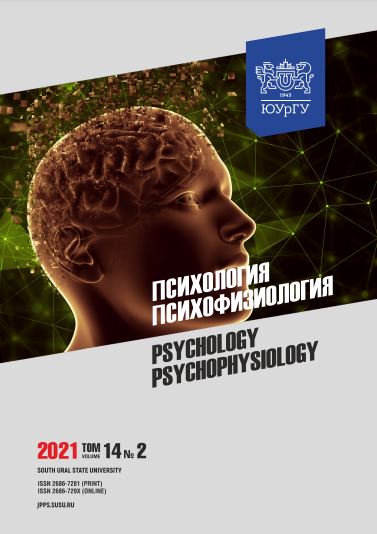PROGNOSTIC VALUE OF EEG MODIFICATIONS AFTER NEUROBIOFEEDBACK TREATMENT IN ATHLETES
Abstract
Abstract. The scientific work of the last decade demonstrates the active use of biofeedback in elite training. However, the main attention is paid to the protocols for neurobiofeedback sessions and their final result (improving the functional state, competitive performance, etc.), while changes in central regulatory mechanisms remain insufficiently studied. Aim. The paper aims to study the prognostic value of neurodynamic changes in EEG indicators after neurobiofeedback treatment in elite athletes. Materials and methods. The study involved elite athletes of various sports. The first group included athletes with a title of the Candidate for Master of Sports (n = 18), the second group consisted of Masters of Sports and International Class Masters of Sports (n = 22). The average age of participants was 18.4 ± 0.1 years. All athletes underwent a 15-day neurobiofeedback treatment with the BOSLAB-ALPHA equipment aimed at increasing EEG spectral power in the alpha range. Before and after neurofeedback treatment, EEG was recorded in athletes under standard conditions (lying with closed eyes, monopolar electrode placement, reference ear electrodes). Brain biopotentials were found for 16 leads in four frequency ranges. For all athletes, the effectiveness of competitive activity was assessed, which was considered successful if it exceeded the result obtained at previous competitions of the same rank. Statistical analysis of the data obtained was carried out using the SPSS 13.0 software product. Results: Analysis of the results obtained showed no differences in terms of neurobiofeedback success between the groups studied. The probability of a match between successful treatment and successful performance in the first group was not established, while in the second group it was 71 % (r Kendall = 0.42; at p = 0.024). Discriminant analysis showed that predictors of successful performance included different combinations of post-training EEG indicators. Conclusion: The results obtained reveal different correlations between successful neurobiofeedback treatment and successful performance among the Candidates for Master of Sports, Masters of Sports or International Class Masters of Sports. Each group is characterized by its own combination of post-training EEG indicators, which allows to accurately predict successful performance in athletes.
Downloads
References
2. Blumenstein B., Orbach I. Biofeedback for Sport and Performance Enhancement. 2014. DOI: 10.1093/oxfordhb/9780199935291.013.001
3. Christie S., Werthner P. Prestart psychophysiological profile of a 200-m canoe athlete: A comparison of best and worst reaction times. Biofeedback. 2015; 43 (2): 73–83. DOI: 10.5298/1081-5937-43.2.05
4. Harvey R.H., Beauchamp M.K., Saab M. et al. Biofeedback reaction-time training: Toward Olympic gold. Biofeedback. 2011; 39 (1): 7–14. DOI: 10.5298/1081-5937-39.1.03
5. Mikicin M., Orzechowski G., Jurewicz K. et al. Brain-training for physical performance: a study of EEG neurofeedback and alpha relaxation training in athletes. Acta Neurobiol Exp. 2015; 75: 434–445. https://pubmed.ncbi.nlm.nih.gov/26994421/
6. Ferguson K.N., Hall C. Sport Biofeedback: Exploring Implications and Limitations of Its Use. The Sport Psychologist. 2020; 34 (3): 232–241. DOI: 10.1123/tsp.2019-0109
7. Fedotchev A.I. On Efficiency of Biomanagement with Negative Feedback from Patient's EEG in Correction of Functional Disorders, Caused by Stress. Fiziologiya cheloveka = Human physiology. 2010; 36 (1): 100–105. (in Russ.). https://www.elibrary.ru/item.asp?id=13044751
8. Xiang M.Q., Hou X.H., Liao B.G. et al. The effect of neurofeedback training for sport performance in athletes: A meta-analysis. Psychology of Sport and Exercise. 2018; 36: 114–122. DOI: 10.1016/j.psychsport.2018.02.004
9. Dupee M., Forneris T., Werthner P. Perceived outcomes of a biofeedback and neurofeedback training intervention for optimal performance: Learning to enhance self-awareness and self-regulation with olympic athletes. The Sport Psychologist. 2016; 30 (4): 339–349. DOI: 10.1123/tsp.2016-0028
10. Salimnejad Z., Zandi H., Arsham S. Effect of Bio-Neural Feedback Exercises on the Performance of Female Rugby Players. International Journal of Motor Control and Learning. 2019;
1 (2): 10–18. DOI: 10.29252/ijmcl.1.2.10
11. Rogala J., Jurewicz K., Paluch K. et al. The do's and don'ts of neurofeedback training:
A review of the controlled studies using healthy adults. Frontiers in human neuroscience. 2016; 10: 301 (1-12). DOI:10.3389/fnhum.2016.00301
12. Cherapkina L.P., Tristan V.G. The characteristics of the cerebrum bioelectrical activity of the sportsmen. Vestnik Yuzhno-Uralskogo gosudarstvennogo universiteta. Seriya Obrazovanie, zdravookhranenie, fizicheskaya kultura = Bulletin of South Ural State University. Series Education, Healthcare, Physical Education. 2011; 39 (256): 27–31. (in Russ.). https://www.elibrary.ru/item.asp?id=17217749
13. Soroko S.I., Trubachev V.V. Neurophysiological and psychophysiological bases of adaptive biofeedback. St. Petersburg. Politechnika-service, 2010: 607. (in Russ.). https://www.elibrary.ru/item.asp?id=19500991
14. Stark M.B. Biofeedback: research and practical components. Bulletin of the Siberian Branch of the Russian Academy of Medical Sciences. 2004; 24 (3): 8–9. (in Russ.). https://www.elibrary.ru/item.asp?id=9126480
15. Dupee M., Werthner P., Forneris T. A Preliminary Study on the Relationship Between Athletes' Ability to Self-Regulate and World Ranking. Biofeedback. 2015; 43 (2): 57–63. DOI: 10.5298/1081-5937-43.2.01
16. Strizhkova O., Cherapkina L., Strizhkova T. The neurofeedback course using of high skilled gymnasts at competitive period. Journal of Human Sport and Exercise. 2014; 9 (1): S561–S569. DOI: 10.14198/jhse.2014.9.Proc1.47
17. Konareva I.N. Modifications of the EEG frequency pattern in humans related to a single neurofeedback session. Neurophysiology. 2005; 37 (5-6): 388–395. https://link.springer.com/ article/10.1007/s11062-006-0015-0
18. Dzhos Yu.S., Men'shikova IA. Possible use of neurofeedback to increase the functional capacity of the brain (review). Zhurnal mediko-biologicheskikh issledovanii = Journal of Medical and Biological Research. 2019; 7 (3): 338–348. (in Russ.). DOI: 10.17238/issn2542-1298.2019.7.3.338
19. Haier R.J., Siegel Jr B.V., Nuechterlein K.H. et al. Cortical glucose metabolic rate correlates of abstract reasoning and attention studied with positron emission tomography. Intelligence. 1988;
12 (2): 199–217. DOI: 10/1016/0160-2896(88)90016-5
References on translit
Copyright (c) 2021 Psychology. Psychophysiology

This work is licensed under a Creative Commons Attribution-NonCommercial-NoDerivatives 4.0 International License.



